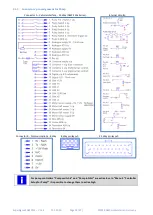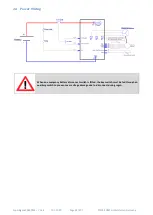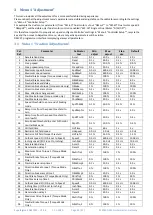
SuperSigma2 AM PMS
–
V1.5.6 17-1-2020
Page 9 (97)
©2019 DMC GmbH Herten Germany
1
About this manual
This manual can be used together with the SuperSigma2 PMS Quick Reference Manual V01.02.02 SW 02.09.01 for a better
understanding of settings and parameters. A detailed description of every parameter is reported. This manual is referred
to software release V02.09.01 for PMS traction and pump.
1.1
References
[1]
SuperSigma2 PMS Quick Reference Manual V01.02.02 SW 02.09.01
[2]
SuperSigma2 AN 160105 - SuperSigma2 Can HMI Protocol V1.7
[3]
DMC Display - NEW Display V1.1
[4]
AN181020 Super Sigma2 - PMS Sensorless V1.0
1.2
How settings are numbered in this document
The settings (i.e. parameters) are labeled with the following format:
Mxx-yyz
AAAAAAAAAAAA, “BBBBBBBBB”
Where:
•
xx is the menu’s number;
•
yy is the parameter’s position in the menu;
•
z is a letter that can be either “T” or “P” and stands, respectively for Traction or Pump software;
•
AAAAAAAAAAA is the parameter short description;
•
BBBBBBBBBBBB is the text which appears on the DMC Calibrator’s menu;
For example
M1.2T
Deceleration delay “Decel”
•
1 is the calibrator menu number (in this case Menu 1 Adjustment Setup);
•
2 is the setting number inside the menu 1;
•
T indicates that this parameter is present in Traction software;
•
“Deceleration delay” is a short description of the parameter;
•
“Decel” is the
text label appearing on the calibrator display;
1.3
How to correctly and time-efficiently setup a controller
This paragraph aims at briefly explaining the best procedure for a correct and time-efficient setup of a DMC Supersigma2
Controller.
The SuperSigma2 has 9 parameter menus which can be set up, but several settings are displayed based upon the choice
of other settings in different menus. For a clear Controller tuning the following procedure should be adopted:
1)
Enter the “
“Controller Setup”” and set up the basic controlle
r settings. (Mind that the setting of several
parameters such as “
M3-16T Active low or high digital inputs
”” should be coherent with the hardware
wiring performed).
2)
In case a Sigmagauge or a DMC Display is used, or the chopping on outputs 1, 2 or 3 is used,
enter the “
” menu and setup the parameters for BDI calculation.
3)
Enter the “Menu 4 “PMS
”” and set up the motor’s basic set of parameters necessary to
perform autotuning. Mind that the parameters “
M4-9 Maximum RMS motor current
” are very important, as they define the maximum current that will flow into the motor (and
thus the maximum deliverable torque) and the maximum rotor speed, on which all the speed limits and ramps
will be based.
4)
Enter the “Menu 7 “Limits Setup”” and set up the desired limitations.
5)
Perform the autotuning.
6)
In case the
controller should operate in a CAN network, enter the “Menu 9 “CAN Bus Setup”” menu and setup
all the CAN communication parameters.
7)
Enter the “Menu 1 “Adjustment”” menu and setup all the necessary adjustments. It is very important to modify
the settings in this menu only when the above steps have been completed, as several adjustments are available
only when some combination of parameters in other menus are performed.
8)
If necessary, modify the parameters in “










































